What is ice defense in basketball
Ice defense, also known as blue, down, or push, is a basketball defensive tactic that focuses on limiting scoring options generally from the side pick and roll action of the offensive player in possession of the ball as well as the screener who would typically roll to the basket after setting the screen.
Ice defense was initially popularized by Coach Tom Thibodeau and it could be useful if the on-ball screener and/or player in possession of the ball are below average perimeter shooters.
Additionally, ice defense features some similarities with the defensive tactic known as drop coverage, particularly because the screener’s defender stays below the screen near the free throw line extended area inside of the arc.
However, unlike the drop coverage tactic, the on-ball defender does not fight through the screen. Instead, the on-ball defender should get above the screen and turn towards the sideline, parallel to the screen.
This essentially forces the offensive player with the ball away from the screen and towards the baseline.
When that occurs, the ice defense tactic would effectively shrink the court and as a result, the player in possession of the basketball would generally have limited passing and/or scoring options.
Essentially, the player with the ball would primarily be able to settle for a potential low quality jump shot that most likely would be contested by the on-ball defender.
Alternatively, instead of taking the potential low quality shot, the player that has possession of the ball would typically only be able to pass to the screener as opposed to having multiple passing options on both sides of the court.
Furthermore, if the on-ball screener rolls to the basket, then the screener’s defender could simply slide over near the paint and when that occurs, the on-ball screener would have to shorten the roll away from the basket.
Therefore, even if the screener does receive the ball, then that offensive player would have to settle for a jump shot or possibly pass the ball to another teammate.
Conversely though, if the player in possession of the ball does happen to get below the screener’s defender by attacking the rim on the baseline side, then a weak side wing should consider sliding over near the paint as a help defender to limit the roll action of the on-ball screener when necessary.
In addition to that, the screener’s defender and the on-ball defender could set a baseline trap on the ball handler as well, assuming the corner is empty on the ball side.
What are simple examples of ice defense
Ice Defense – Example 1
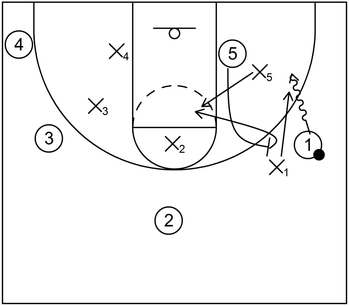
This is an example of the ice defense which demonstrates how the on-ball defender pushes the ball handler towards the baseline to generate limited scoring options for the offensive team.
1 receives the on-ball screen from 5 and when that occurs, X1 executes ice defense to push 1 towards the baseline.
Next, X5 attempts to contain 1 for about a second while X1 recovers. After that, 5 begins to roll to the basket but X1 recovers to defend 1.
This in turn allows X5 to slide over and take away the roll towards the basket. At this point, the ice defense was a success so 1 has to settle for a contested jump shot or pass to other teammates.
Related: NBA Defense: How to ICE the Pick And Roll
Ice Defense – Example 2

This is an example of the ice defense which shows how the defense could use the stunt technique if the offense counters the ice defense with pick and pop action.
1 receives the ball screen from 5 and when that occurs, X1 executes ice defense to push 1 towards the baseline.
However, instead of rolling to the basket, 5 counters the ice defense by popping out towards the top to receive the ball from 1.
When that occurs, X3 stunts at the ball for about a half-second, shown with the gray arrows, as a method to disrupt the jump shot rhythm of 5.
At the same time, X5 sprints to closeout on 5 while X3 quickly recovers to the original assignment, indicated as 3.
Ice Defense – Example 3
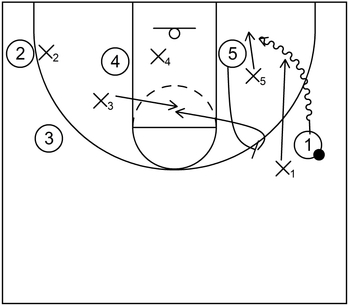
This is an example of the ice trap action which displays how the defense could set a trap near the baseline if the player in possession of it dribbles below the screener’s defender.
1 receives the ball screen from 5 and when that occurs, X1 executes ice defense to push 1 towards the baseline.
Unfortunately, 1 quickly dribbles below X5 and when that occurs, X5 should try to cut off the lane towards the basket by pushing 1 further towards the baseline.
At the same time, X1 should sprint to catch up to the ball and from that point, X1 and X5 could set a baseline trap against 1.
However, 5 would be able to roll to the basket but this could be disrupted by having X3 slide over towards the paint. When that happens, 5 would be forced to shorten the roll away from the basket.
From that point, 1 would have to pass to other teammates that are covered by defenders or execute a long pass to 3, in which X3 would be able to recover.
Affiliate Disclosure: I may earn a commission on qualifying purchases made through the links below.
What is a breakdown drill to practice ice defense
Ice Defense Drill – Part 1
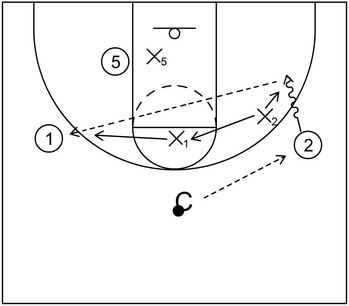
This is a brief 3-on-3 drill which seeks to breakdown the ice defense action derived from Pack Line Modifications to Stop the Pick-and-Roll by Coach Matt Woodley. 1 and 2 are near the wings while 5 is near the left side low post block.
Additionally, X1 starts at the nail spot near the free throw line while X2 starts near the right side wing area to cover 2.
The drill begins when 2 receives the ball from the coach, indicated by the letter C. Following that, 2 takes one or two dribbles toward the baseline and then throws the skip pass to 1. Afterwards, X1 executes a closeout while X2 sprints to the nail spot.
Ice Defense Drill – Part 2
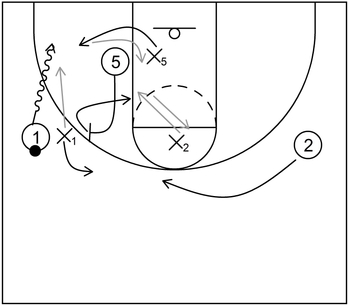
Next, 5 attempts to execute a side pick and roll but that gets countered with the ice defense of X1. After that, 1 dribbles toward the baseline while 5 rolls to the basket.
Afterwards, X5 steps out to contain 1 near the short corner until X1 recovers, shown with the gray arrow. While that happens, X2 drops back from the nail to slow down the effectiveness of the roll from 5.
After that, X2 gets back to the nail while 5 recovers, shown with the gray arrows. Also, at the same time, 2 cuts to the top and could receive the skip pass from 1. If 2 receives the skip pass, then 2 could either try to score or make a play for another teammate.
Related: Ice Ball Screen Breakdown Drill – YouTube
How can the offensive team beat ice defense
The offensive team could use ball screen rejection as the primary counter against the ice defense. Ball screen rejection occurs when the player in possession of the ball rejects or refuses the ball screen and then dribbles to the opposite side of the screener.
From that point, that same offensive player could either attack the rim or take the open jump shot, typically from the mid-range area.
This is also particularly effective if the strong side corner is empty and not occupied by another offensive player.
Ball Screen Rejection Vs. Ice Defense – Example 1
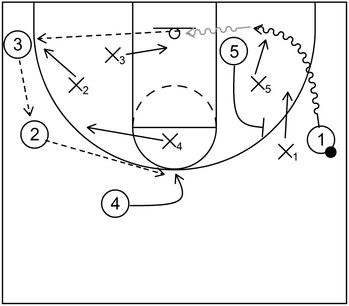
This is an example of ball screen rejection vs. the ice defense that the offensive team could implement to generate scoring opportunities.
Additionally, this particular diagram demonstrates possible defensive rotations that could occur and offensive counters to those rotations.
To start, X1 takes away the ball screen set by 5 by executing ice defense. When that occurs, 1 rejects the ball screen and beats the ice defense by dribbling toward the baseline. As that happens, X5 proceeds to cut off the baseline drive.
Following that, 1 can take the mid-range jump shot if there is an opening or continue to dribble towards the basket to score via a layup/dunk, represented by the gray arrow.
Also, in some instances, X3 could execute weak side help defense by sliding into the lane to protect the basket and prevent the easy layup. If that occurs, then 1 could throw a drift pass to 3 in the left corner who could then take the open jump shot.
However, X2 would most likely stand in the gap between 2 and 3 which allows a possible closeout on 3. If that happens, 2 could receive the ball from 3 and take the jump shot if open.
At the same time, X4 may decide to closeout from the nail spot near the free throw line and if that happens, then 4 could cut towards the top. Following that, 4 could receive the ball from 2 and take the open jump shot.
Ball Screen Rejection Vs. Ice Defense – Example 2
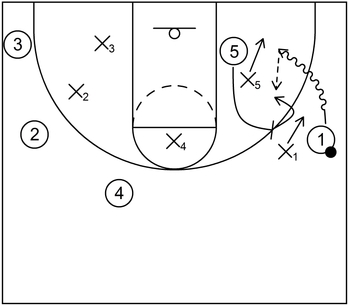
This is an example of ball screen rejection vs. the ice defense that shows the screener executing pop action instead of rolling to the basket. To start, 1 beats the ice defense by refusing the ball screen.
However, X5 is able to cut off the drive towards the baseline. When that occurs, 5 could pop to the open space between X1 and X5 and receive the ball from 1 via a pocket pass. Afterwards, 5 can take the open mid-range jump shot.
Ball Screen Rejection Vs. Ice Defense – Example 3
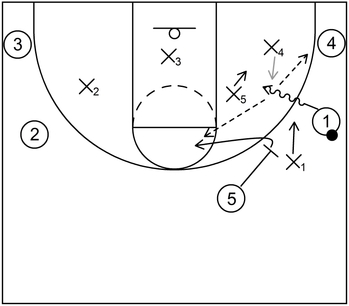
This is an example of ball screen rejection vs. the ice defense that occurs when an offensive player occupies the ball side corner. To begin, 1 rejects the ball screen and begins to drive towards the basket.
Next, X5 would most likely cut off the driving lane and at the same time, X3 could step into the lane to mitigate another potential scoring option if 5 decides to slip the screen.
So to counter that, 5 could pop towards the free throw line area which is the open space on the court. Afterwards, 5 could receive the ball from 1 via the pocket pass and take the mid-range jump shot.
Additionally, in some instances, the defense could make a mistake, represented by the gray arrow of X4, by attempting to completely stop the ball as opposed to simply executing a stunt maneuver while an adjacent offensive player is only one pass away from the player with the ball.
If that happens, then 4 could receive the ball from 1 and take the open three-point shot before X4 recovers to contest the jump shot.
Related: Ice Defense – The Basketball Dictionary